Chickens are often associated with farms and country-living. However, many people in urban and suburban communities have begun to add small flocks and coops to their backyard and it’s easy to see why. Chickens are friendly and easy to care for and fresh, delicious eggs are only one of the benefits. They also help control insects, can get rid of kitchen scraps, and chicken poop is an excellent addition to your compost pile. They don’t take a lot of space, so even if you have a tiny yard chickens may be for you.
Check the Law
Before looking at anything else the first thing you should do is read up on your local laws and regulations. Some communities may ban roosters, but allow hens. Some may put a limit on your flock size and regulate where you can put your coop. You may also be required to obtain a building permit before you add a coop. Check with your local municipality and, if hens are banned, work to change the law before adding chickens to your backyard.
Raising Baby Chicks
The chickens you purchase will most likely be newly hatched chicks. Newly hatched chicks will not be raised by their mothers so you’ll need to set up an environment, called a brooder, that is hen-like and will allow the chicks to grow and thrive. Brooders need to be warm, secure, clean, and have access to food and water. This is generally a cardboard box with wood shavings, or corn cobs next to a heat lamp. Place a chick-sized waterer and feeder in the box with the chicks.
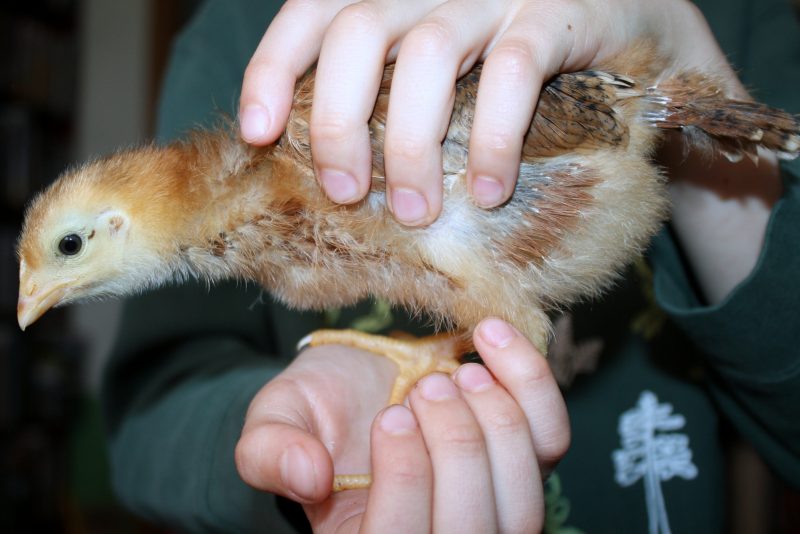
Rhode Island Red Chick
Chicks need to stay in the brooder for the first 8 weeks of their lives. It is a good idea to purchase your chicks in the spring-time, 8 weeks before the night-time temperatures consistently stay above 55 degrees.
Once the brooder is set up add the chicks and make sure they always have clean water and food. Chicks need to be fed chick feed until 8 weeks old, then starter or grower feed until 18 weeks. Place the brooder in a safe place away from predators, including other pets. This might be inside in the garage or the basement. Chicks can get messy so don’t place the brooder in a hard-to-clean area.
There are three places where baby chicks are typically purchased. Those places are a farm or hardware store, hatchery, or online hatchery.
Farm Stores
Farm stores usually sell chicks in the spring and the selection will probably be limited. They generally only sell chicks that are straight-run meaning the gender of the birds is undetermined. You have a 50% chance of purchasing hens. Chicks that labeled “sexed” or “pullet” means the gendered has been determined and they are hens. If want you to be sure you’re only purchasing hen chicks rather than roosters, a hatchery may be your best choice.
Hatcheries
Hatcheries often offer a greater selection of breeds and you’ll be able to order exactly what you want. They also are better at sexing chicks and the chicks will typically be in better health as well. If you don’t have a local hatchery there are many online ones that will suit your needs. The downside to online hatcheries is that shipping can be stressful on the chicks and you may lose some in the process, particularly if the weather is cold.
Chickens are social birds. Don’t select less than three birds when starting your flock. Hens can lay as many as 2-3 eggs per day once they start laying and with 3 hens you can collect as many as a dozen eggs per day. It can be tempting to want to purchase a lot of chicks because they are so tiny. Keep in mind they will get bigger and will have all the food, space, and poop requirements of an adult bird. A small flock is good to start so you can be sure to give each bird the care it deserves while you are getting started. You can always add more birds later.
Chicken Breeds
Before purchasing chicks it’s a good idea to do some research to determine what breeds will work best for you. Just like breeds of dogs have different traits and personalities, so do chickens. Some breeds are anxious and flighty while other can be cuddly and friendly. You can find breeds that lay colored eggs, breeds that are excellent egg-layers and breeds that are better suited for hot or cold climates.
Most breeds come in two sizes, standard and bantam. Standard size birds are also known as large breed. Bantam hens smaller than standard, usually about one quarter the size. Standard breeds lay larger eggs and bantams tend to be less flighty. Both types can work well in a backyard coop. Below are some of the best breeds for beginners.
Rhode Island Red
Rhode Island Reds are a dual-purpose chicken breed dating back to the 1800s and are one of the best egg-producing dual-purpose breeds. They are cold hardy, meaning they tolerate cold weather. If you are unsure what type of breed to select for your climate, pick the Rhode Island Red. They also have a hardy temperament and will lay eggs even in poor conditions. They are excellent foragers so are a good choice for free-range or penned birds. If they are to remain penned try to move the pen to different locations to allow for foraging. They produce brown eggs and will usually lay between 150-200 eggs per year, about 5 times a week. Hens start laying eggs around 18-24 weeks in age. Rhode Island Reds can be a bit aggressive or bossy towards smaller birds, but if handled frequently with lots of human interaction as chicks they may be more easy-going. Adult hens grow to about 6 ½ pounds.
Brahma
The Brahma breed is a popular choice because their docile, gentle and sweet temperament making them a great family pet. The breed originates from India and is one of the largest chicken breeds with the hens weighing about 8 pounds. They have a pea comb, and feathered feet giving them a striking appearance as well as to help protect them in cold weather. Pea combs are combs that run length-wise from the beak toward the back of the head with three rows, the tallest in the middle. Pea combs are low to the head which reduces the chances of frostbite in cold weather. The Brahma is a dual-purpose bird originally raised for its meat, but because of its slow-growth it isn’t used in commercial production. They are good egg layers and will lay around 100-150 eggs per year, about 3 times per week. They tolerate confinement making them suitable choices for penned birds.
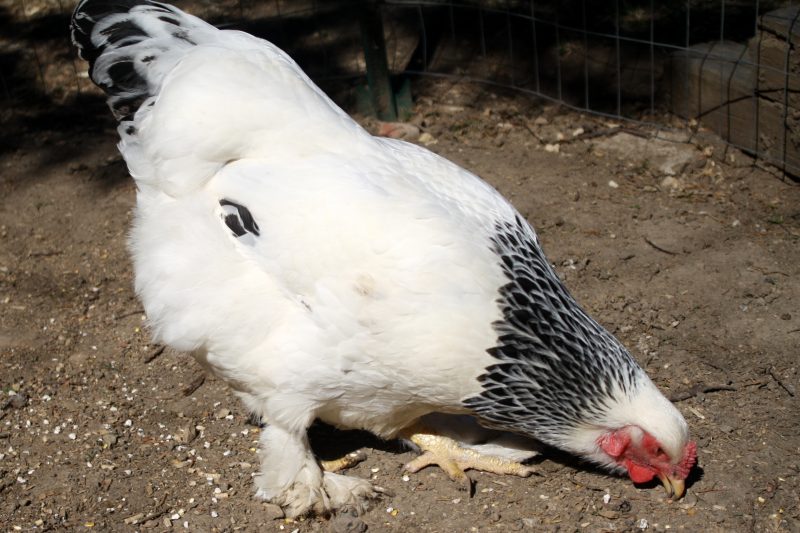
Brahma Chicken
Wyandotte
They Wyandotte breed originated in the northeast in the late 19th century. They are popular with small backyard flocks for their dependable laying and relaxed nature. There are several varieties of feather pattern such as Golden Laced and Silver Penciled, giving them a stunning appearance. Mature hens are fairly large and weigh between 7 and 8 pounds. They are dual-purpose birds, and are excellent egg producers laying about 200 brown eggs a year, or about 4 per week. They generally start laying around 18-20 weeks. They have a rose comb which is less susceptible to frost-bite making them cold hardy, and able to tolerate many climates. Rose combs lay flat or close to the head. Sometimes the rose comb will form a point that extends past the head. They tolerate confinement, but are also good foragers making them excellent backyard birds as either free-range or penned. Wyandottes are generally pretty docile, but have a tendency to be the dominant bird.
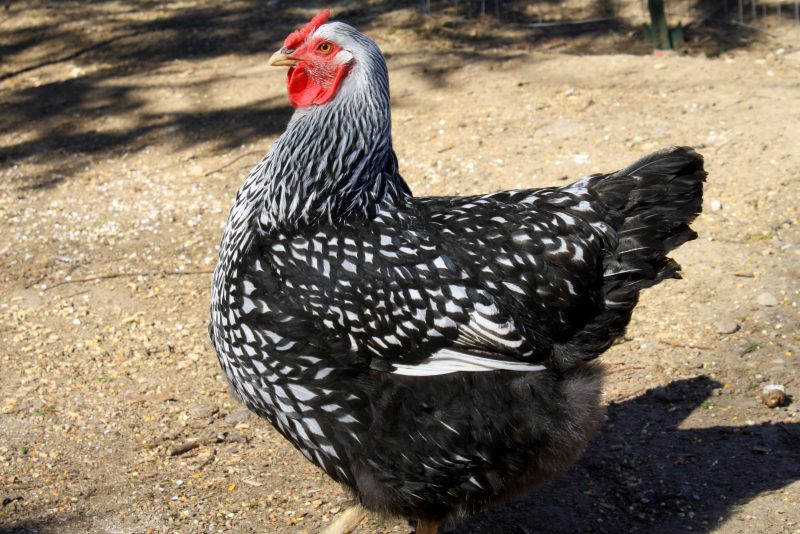
Wyandotte Chicken
Australorp
The Australorp is a beautiful bird that has black feathers with a green or purple sheen originally from Australia. They have a single comb. The single comb is the most common type of comb on a chicken. It is a single row of spikes beginning at the beak and going towards the back of the head. They are a dual-purpose breed and can lay about 250 brown eggs per year, about 5 per week. Hens weigh between 6 and 8 pounds and begin laying around 22-24 weeks. Their large size makes them cold hardy. Australorps are one of the friendliest chickens towards humans making them a wonderful pet and an excellent choice for beginners. Don’t raise Australorps with aggressive breeds as they may be bullied.
Sussex
The Sussex breed is one of the oldest breeds available today. It is a dual-purpose bird originating from England and initially raised for their meat. The most common variety is the Speckled Sussex with multi-colored plumage, a single red comb. Sussex birds are curious and docile making them wonderful pets. They are a larger bird weighing between 7 and 8 pounds. The added weight makes them cold hardy and some will even continue to lay eggs in cold weather. The large size also makes them unlikely to fly so can be easily fenced in. They are foragers, but also tolerate being confined. These excellent layers will lay between 250 and 300 light brown eggs a year, about 4 times a week. Hens begin to lay eggs around 16 to 20 weeks.
Delaware
The Delaware breed was developed in the United States in the 1940s as a dual-purpose bird with the primary use being its meat. These beautiful birds are mostly white with black barred plumage near the neck and on the tail. They have a single red comb which can get frost bitten in the winter. Protect the comb by applying petroleum jelly. Delaware Hens are not known to be aggressive and are gentle, friendly, and calm. They are generally cold hardy, but their comb can sometimes become frost-bitten in the harshest weather. Protect combs with a bit of petroleum jelly. They are good egg layers and will produce between 100 and 150 brown eggs per year, about 4 eggs per week. The hens will weigh between 7 and 8 pounds.
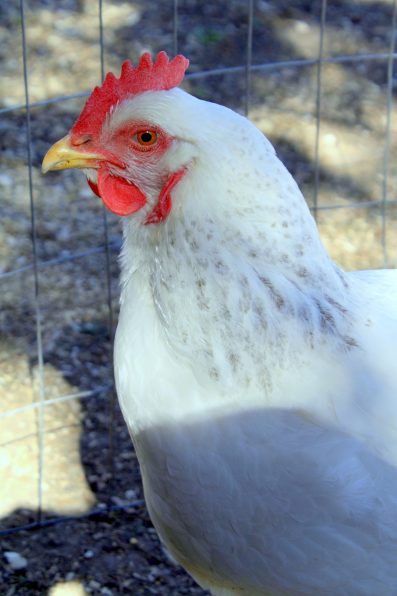
Delaware Chicken
Plymouth Rock
The Plymouth Rock breed was developed in the United States in the mid-19th century. It is a very friendly, calm, and docile breed and great for families. It is a dual-purpose breed originally developed for its meat. Hens weigh around 7 pounds and generally lay around 250 brown eggs per year, about 4 per week. They have a single red comb and are cold hardy. Plymouth Rock hens can be penned or free-range and get along with most other breeds.
Star
Star chickens are a breed that are sex-linked meaning they’ve been bred so that males and females are a different color when hatched. Males are sometimes used for their meat. Hens come in two colors; Black Star and Reds Stars which are brown. They have a single comb and mature hens weigh between 6 and 7 pounds. These dual-purpose birds were breed for their meat, but are excellent egg-layers and will continue to produce in heat and cold while other breeds may slow down. They lay about 5 eggs per week, as many as 200 brown eggs per year. They are suited to live in confinement making them good backyard hens.
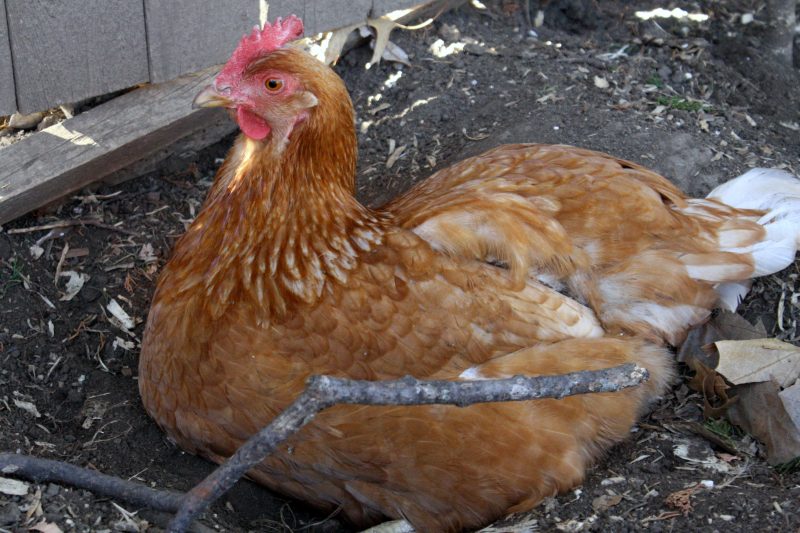
Red Star Chicken
Leghorn
There are many varieties of the Leghorn breed, but the White Leghorn is the best for laying eggs. The breed originated in Italy and was brought to America in the mid-nineteenth century. The White Leghorn is all white and will lay about 280 white eggs per year, about 4 a week. The breed can be a bit nervous or flighty so they do best when penned. They are cold hardy, but can develop frost bite on their single combs. They begin to lay eggs between 16 and 17 weeks. They are smaller birds; the hens only weigh around 5 pounds. They capable of short flights and will roost in trees if able. That is another reason to keep them mostly penned.
Ameraucana
The Ameraucana are a hardy, sweet that produce eggs in shades of blue. They are unique in appearance in that they have a muffs and a beard rather than ear tufts and a pea comb. The muffs and beard are the feathers that grow on the ‘cheeks’ and ‘chin’ of the chicken. The lack of excessive exposed skin make the breed an excellent cold-hardy one. The hens are medium sized weighing 6 to 7 pounds and will lay about 250 eggs per year, about 3 eggs per week. Hens begin laying eggs around 25 to 30 weeks. They tolerate confinement in a pen. They have a docile, sweet personality making them well-suited for family pets.
Coop
When your chicks are ready to come out of the brooder they’ll need a permanent location to live. A chicken coop provides shelter to chickens. You can purchase a coop, use existing structures such as an old playhouse, or build your own. The coop should be large enough to give each hen about 3-5 square feet of floor space. If you are planning to have 3 hens you’ll need a coop with at least 9 square feet of floor space. It is better to have more space per chicken than less. Over-crowded conditions do not make happy chickens. It is also better to plan for a larger coop than you’ll need. You can easily add more chickens if you find your coop too large, but it is more difficult to add more space to the hen house.
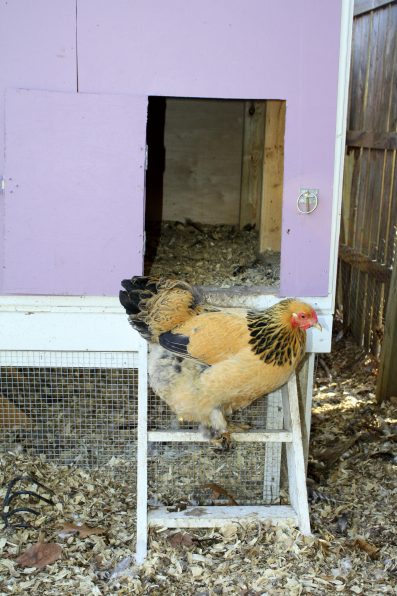
Brahma Outside Coop
Provide a Safe and Healthy Nesting Area
You should also add one nesting box for every 3-4 hens. The nesting boxes should be about 1 foot in length, width, and height. Chickens are not particular about where they lay their eggs, but providing a box will encourage them to lay them there making it easier for you to collect. Boxes can be pretty basic, but should be easy to clean and sterilize. You will also need to be able to access the boxes easily to retrieve eggs. This can be done with a door on top of the boxes. Nests can be lined with straw, wood shavings, hay, grass clippings or shredded paper. Natural materials such as straw and hay may become moldy which is unhealthy for chickens. Rubber mats can be purchased to line the beds which are easy to clean and healthy for hens. Natural materials are fine if you clean the nests every 4 to 6 weeks. Keep the nests in the darkest part of the coop, away from flock activity outside. You want to encourage the hens to use the nest for egg-laying only and try to prevent them from otherwise soiling them. Line the hen house with some sort of bedding, such as straw or corn cobs to make cleaning easier.
Chickens Need to Roost
Roosting bars are a nice addition, but are not necessary. These are bars inside the coop where the chickens sleep. If you plan to add bars each hen should have 8 inches of roosting bar. The roosts should be at least 2 inches wide at least a foot off the ground and no closer than a foot to the ceiling. Separate the rows by 15 inches, if you have more than one row of roosts to allow the hens space and to prevent the ones on top from pooping on the lower hens. Chickens prefer to sleep off the ground as being elevated keeps them out of reach from predators. Chicken roosts should be placed inside the coop away from food or water so food is not contaminated by poop.
Where to place the chicken coop
The chicken coop should be at least two-and-a-half feet off the ground to prevent the bottom from rotting. The elevated structure also offers the chickens shade in the heat of the day. The floor of the coop should be made from cedar; the rest can be made from pine. Avoid using pressure-treated wood as the chemicals used may be toxic to the birds. Add grates on the top of the house to ensure air circulation. Make sure your coop has a chicken-sized door and some way for humans to enter to retrieve eggs and clean. The coop should be placed in a safe place in your backyard. Next to an existing structure, such as garage or shed can provide extra insulation for the coop.
Protect Your Chickens
Chickens can be allowed access to your yard, but should only do so under supervision. They love to scratch the dirt for bugs and worms, regardless of what you have planted. You also need to be aware of predators. These can be anything from hawks, raccoons, or coyotes. It may be safer to build a run for the chickens which will allow them to be outside, but will also keep them safe. Plan on 10 square feet per hen and line the run with something, such as sand to help clean. The run should be covered with hardware cloth and the fence should be buried by at least one foot. Raccoons can pull apart chicken wire and rodents can squeeze through. Netting can be placed on the top of the run to prevent hawks and other aerial birds from attacking. Keep your hens locked in their coop at night to prevent night-time attacks, when they are most vulnerable.
Feeding Chickens and Care
Chickens need high-quality chicken feed and balanced diet with 16-18% protein. They will dig up part of their diet as bugs, seeds, and plants. Their whole life Their entire diet will consist of chicken feed If they are kept in a coop, or penned. They will supplement their diet with bugs or plants that they can forage if you have a chicken run. Chickens that are allowed free range will receive most of their nutrition from the things they forage. The feed will be mostly supplementary. As a treat, you can also give your chickens organic grass clippings and vegetable scraps.
Free-range chickens are nice in theory. They will find most of their food, saving money on feed, the chickens will be happier and healthier, and the eggs will taste best. However, chickens do have many predators and it may be difficult to keep them safe when ranging. The best of both worlds would be to offer penned ranging. This allows the chickens to roam in a large, secure pen during the day then shutting them in a coop at night.
Chickens also need plenty of water, especially for consistent laying. Chickens may forgo laying eggs if they are without water for even as short as 12 hours. There are many waterers specifically designed for poultry and allows them access to fresh water all the time.
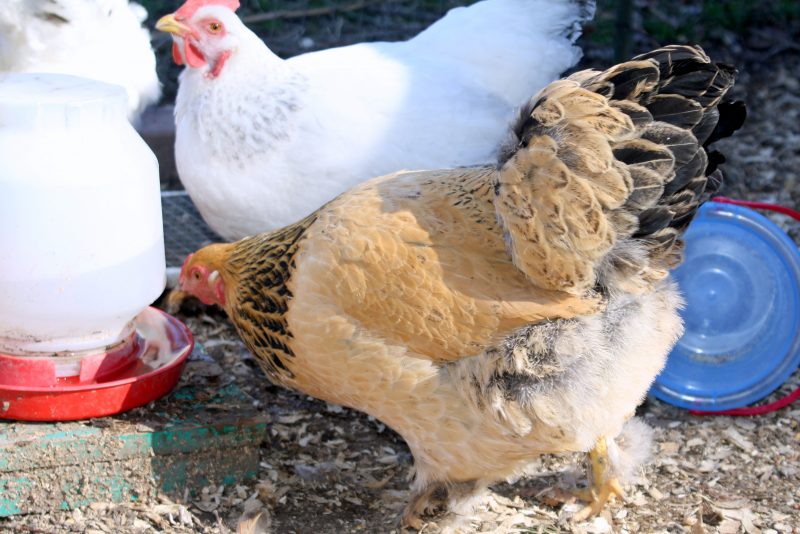
Hens at Water
Chickens live for about 8 to 10 years, but generally stop producing eggs after about 3 to 5 years. Older chickens are sometimes kept as pets. Other owners use them for meat.
How to Raise Chickens
When your chicks are around 5-6 weeks they should begin to lose their fluff and their feathers should start to grow in. This is the time when you should start to introduce your chicks to the outdoors and their new home, the coop. It is a good idea to keep the chickens in the coop for about a week to train the chickens that the coop is their home. This will encourage chickens to lay eggs in the coop as well as return to it if they may range. Chickens that are free range might not know to lay eggs in the boxes in the coop and may choose other places in your yard. You can help the chickens learn to use the nesting boxes by placing dummy eggs in the boxes and by keeping them in the coop when they are first brought outdoors. When chickens see the dummy eggs, they will be more likely to lay there as they like to do as other chickens do. Chickens generally begin to lay eggs around 6 months in age, but this will vary depending on the breed.
Once your flock is established and laying there isn’t much to do. Be sure the coop is stocked with fresh water and food and clean it every few weeks. Keep an eye out for diseases or injuries. You may want to contact your local vet if you suspect a problem. You can also check an active internet forum such as BackyardChickens to help diagnose problems.
FAQ
How long do chickens live?
Chickens generally live for about 8 to 10 years. They lay the most eggs in the first 2-3 years of their lives and usually stop producing eggs around age 5.
How often do chickens lay eggs?
Most chickens will lay between 1 and 3 eggs per day. This will vary depending on the breed, the age of the chicken, and the time of the year. Chickens won’t lay nearly as many eggs in the winter because they need to conserve energy to stay warm. The most active time of the year for egg-laying is the summer.
What are the best egg laying chickens?
Barnevelder, Hamburg, and Buff Orpington are the best chicken breeds for laying eggs. Dual-purpose breeds that are the best laying hens are Rhode Island Red, Sussex, and Maran.
How long do chickens lay eggs?
Chickens usually lay eggs for the first 3-5 years of life.
When do chickens start laying eggs?
Chickens will start laying eggs around 6 months of age. This depends on the breed and the time of year. If chickens mature in the winter, they will probably wait until spring or summer to start producing.
Is chicken poop good for the garden?
Chicken poop, or manure is an excellent addition your garden. It is high in nitrogen and other nutrients that are beneficial to the soil and plants in your garden. It can be added to a compost pile or straight to the garden as a fertilizer.




No Comments